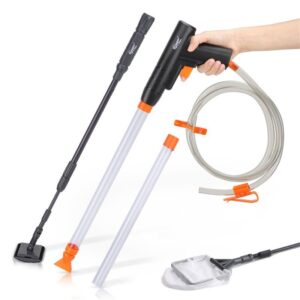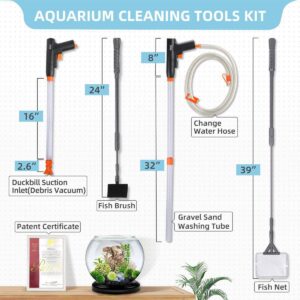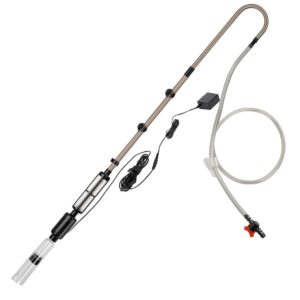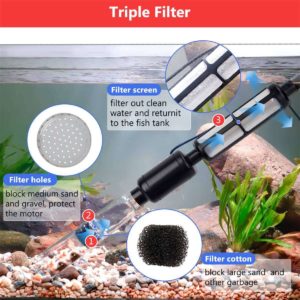Equipment For Cleaning Fish Tank Conveniently
We know making the amazing aquarium is tough, and thoroughly cleaning it is even tougher! As an aquarist enthusiast, it’s important to clean fish aquariums to provide a healthy atmosphere for aquatic creatures. With this concise guide in your back pocket, you can quickly and efficiently start building your healthy aquatic world. No matter if it’s a stunning community fish tank, a peaceful planted piece, or a chaotic coral reef alive with life, you’ll find everything necessary to keep your fish tank cleaning and healthy.
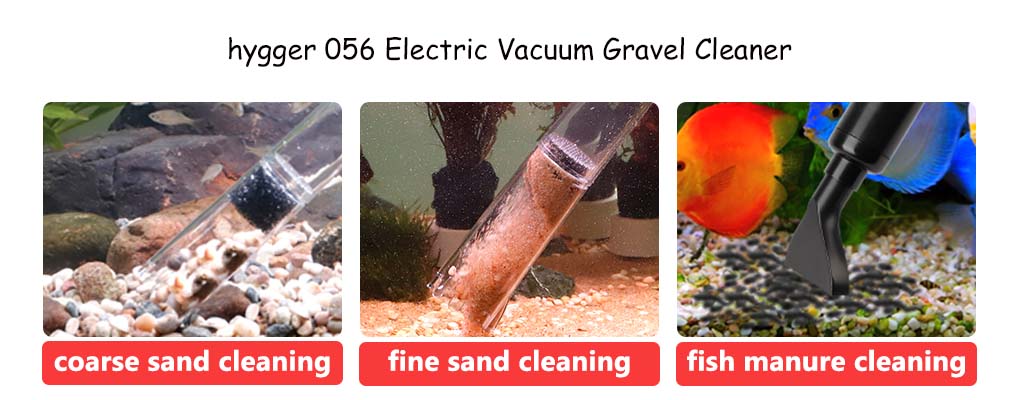
Cleaning Fish Aquarium
Before going deep into the self-cleaning fish tank details, there is a question that every beginner asks:
Is There a Fish Tank That You Don’t Have to Clean?
The answer is no, there won’t be a zero-maintenance fish tank. Even though all aquariums require a certain level of cleaning to provide your fish with a stable environment that is full of life. Nonetheless, an optimal setup allows for most fish tank cleaning tasks to be done efficiently and quickly.
Why Fish Aquarium Need to be Clean?
Fish mainly produce ammonia through their gills and the waste from their bodies. The decomposing of the food, as well as the excess ammonia released, becomes part of the system. Toxicity to fish can be caused by even a minor increase in ammonia in an enclosed space such as a fish tank.
Beneficial bacteria convert ammonia into nitrite, another poisonous substance, but later convert nitrite into nitrate, which is not very toxic. Particularly, partial water changes with great frequencies help to make the nitrate levels less concentrated and do not cause any threat.
If you don’t remove the harmful organic substances that accumulate in them, they will affect the health of your fish and will stress or even kill them. As a consequence, an insanitary tank can also yield undesirable growth of algae. Some algae species block access to plants for nutrients and light, whereas others threaten the lives of the fish. Cleaning algae regularly will prevent it from growing everywhere.
Cleaning Knowledge Before Keeping a Fish Tank You Should Know
First, it’s important to understand the nitrogen cycle, which is the process by which beneficial bacteria break down waste in the tank. This cycle is essential for keeping the water clean and safe for your fish. Second, you should be aware of the importance of regular water changes. Over time, waste and toxins can build up in the water, so it’s crucial to perform regular water changes to keep the tank clean and healthy.
Additionally, you should know how to properly clean the tank itself, including removing algae and debris from the glass and decorations. Simultaneously, it is essential to bring the appropriate cleaning tools, which include but are not limited to gravel vacuum and algae scraper.
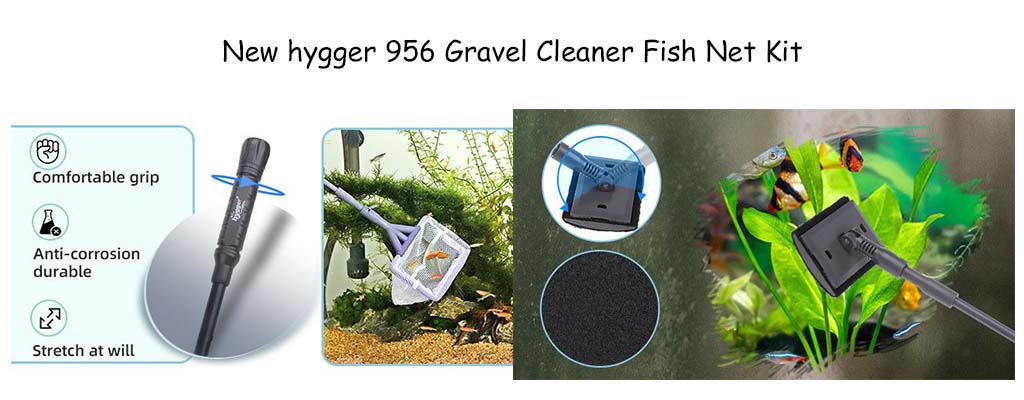
Cleaning Schedule
1. Water Changes
Frequency
- Standard Fish Tank: 25-50% water change every 1–2 weeks.
- Planted Tank: 25-30% water change every 1–2 weeks, possibly less frequently for mature, heavily planted tanks with low bioload.
- Coral Tank (Reef Tank): 10-20% water change weekly, or more frequently for heavily stocked tanks.
- Hardscape/Aquascaping Tank: Follow the general schedule based on bioload, or adjust for specific fish and plant needs.
- Time: Water changes can take 30 minutes to an hour, depending on tank size and equipment.
2. Other Cleaning Tasks
- Gravel Cleaning: During water changes, siphon the substrate with a gravel vacuum.
- Frequency: Weekly for standard tanks, can be less frequent for planted tanks with low bioload.
- Time: 10–20 minutes.
3. Filter Maintenance
- Mechanical Media (sponge): Rinse weekly in tank water to remove debris.
- Biological Media: Rinse gently in tank water every 2–4 weeks, or replace according to the manufacturer’s instructions. Avoid over-cleaning to preserve beneficial bacteria.
4. Algae Removal
- Frequency: As needed, scrape algae from glass and decorations. Some fish also eat algae.
- Time: 5–10 minutes.
5. Hardscape Cleaning
- Frequency: As needed, remove debris and algae buildup from rocks and wood.
- Time: 5–15 minutes.
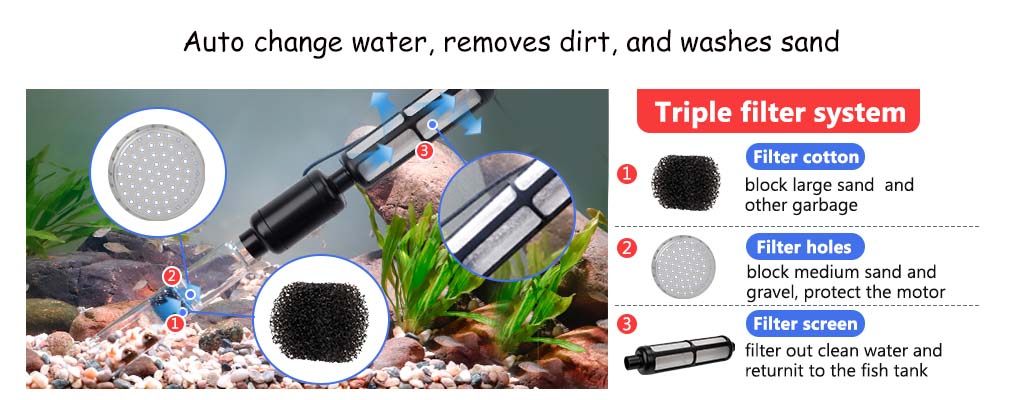
Is Cleaning a Fish Tank Bad for the Fish?
No, a daily cleaning regime is a must for a thriving aquarium. The treatment removes noxious sludge and avoids fish poisons that can reduce or kill fish. Proper cleaning of the aquarium is required so that the fish are not affected and have a comfortable environment. But make sure your fish do not experience stressful conditions while cleaning and moving them frequently to another tank.
Where do you put the fish when cleaning the tank?
In most cases, you can leave the fish in the tank while cleaning! Regular cleaning with partial water changes avoids needing to remove the fish, which can be stressful for them. It’s only in rare cases, like deep cleaning a neglected tank, that you might need to move them to a temporary holding tank.
Equipment for Cleaning Fish Tank
For cleaning the fish tank, you can consider the new Hygger D-956 and 056.
D-956 – Hygger Aquarium Gravel Cleaner Fish Net Kit
The Hygger new 956 kit is a manual gravel cleaner kit for fish tanks with patents. It features a comfortable handle and a soft fish net for safe catching and debris removal. An extendable brush helps clean tank walls. The gravel cleaner vacuums dirt and debris while changing water. The kit includes extendable hoses for deeper tanks (up to 31 inches) and is suitable for most freshwater and saltwater aquariums.
Pros
|
Cons
|
056 – Hygger Electric Vacuum Gravel Cleaner
The Hygger 056 gravel cleaner is an electric gravel cleaner that vacuums waste, cleans sand, and changes water in your fish tank. It has a reusable filter and different attachments for each function. The strong pump makes cleaning fast and frees your hands during water changes. This user-friendly cleaner is perfect for various large aquariums.
Pros
|
Cons
|
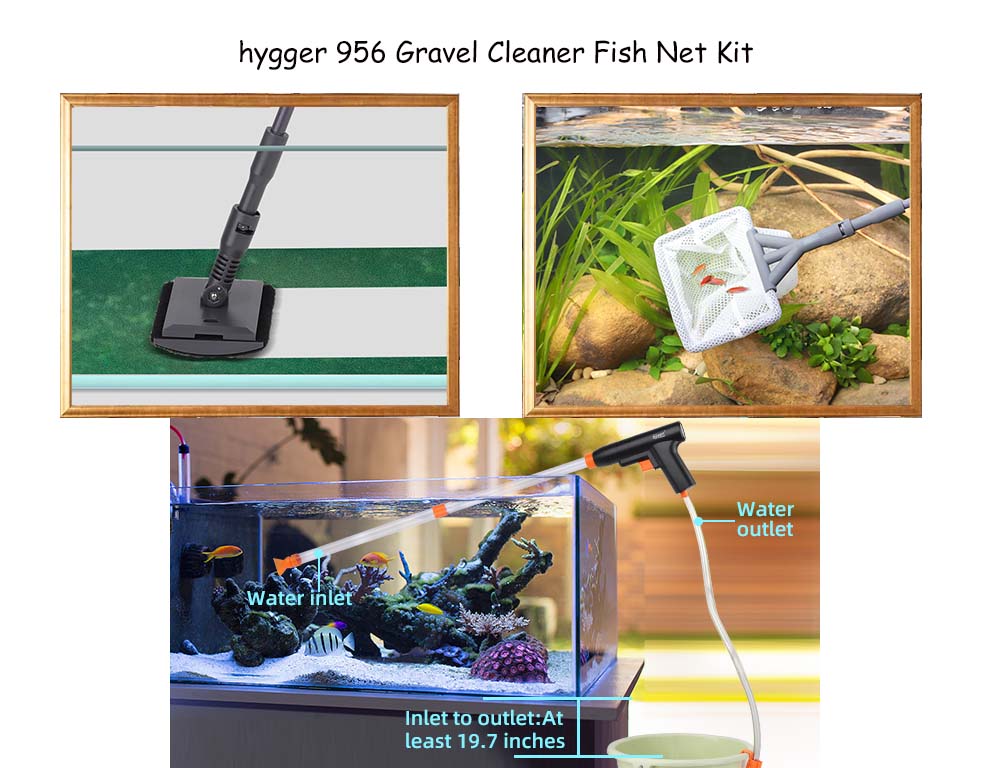
How to use Cleaning Tools in the Corresponding Fish Tanks
Hygger D-956
1. Put the water hose together with the inlet tube.
2. Press the trigger.
3. Insert gravel into a tube and try to move back and forth to remove dirt; lift and down to replace gravel; wash the wool this way all the time.
4. Pure water, now, washes down the gravel while taking along with it the suspension of impurities that lag through the outlet hose.
Hygger 056
1. Install a sand wash head with a screen filter at the bottom of the Wet/Dry Water pump.
2. Connect one end of the tube to the inlet pipe while installing the same, and pass it through the U-shaped pipe.
3. Now install the outlet pipe with an On\Off valve. When done, plug the pipe into the adapter and use the pipe directly.
What to Do After Cleaning?
Once you have thoroughly cleaned your fish tank, the next action would be to move any aquatic creatures back to the tank. This can be done by putting them in a bag or container in the aquarium for approximately 15–20 minutes, slowly acclimating them to the new water conditions. During this period, they will become accustomed to the temperature and pH of the water in the tank.
Subsequently, you may reintroduce any tank decorations or plants that had to be disposed of during the cleaning procedure. To ensure a clean environment for your fish pets, make sure to rinse them completely with the tank or clean water before putting them back in the tank.

